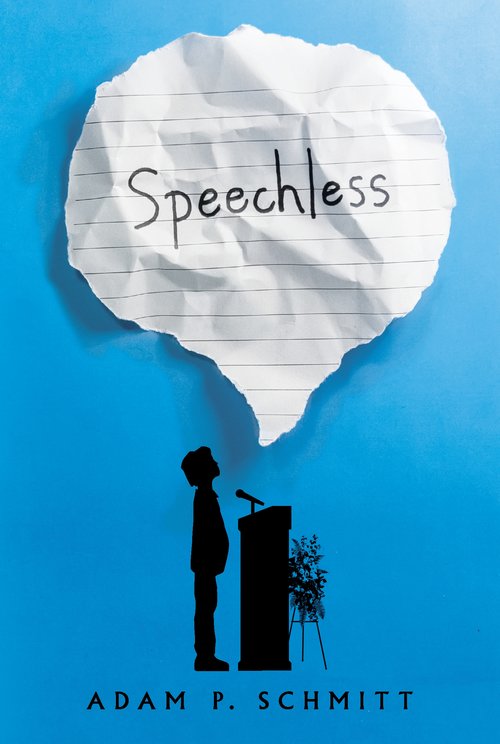After reading Adam P. Schmitt’s debut middle grade novel Speechless, I was… speechless. No, really. I was. Seriously. Toward the end, through a secondary character named Sofia, Schmitt crafted an unexpected turn, and I marveled at the story’s depth. (No spoilers here. You’ll have to read it!)
I loved this novel, so I went looking for Adam and begged for an interview. Turns out, I didn’t need to beg. He said, “Sure!” And that means—lucky you! One reader will win a copy of Speechless. Hop to the end of this post to enter the giveaway, then come on back to hear how Adam crafted such a great book. Deadline to enter: Tuesday, April 30, 2019, at 11:59 PM.
Adam, welcome to my blog! I’m so glad you could share some thoughts about craft.
Adam P. Schmitt: Thanks for tracking me down.
ABW: I want to ask about the wonderful secondary character, Sofia, but we’ll get to her in a minute. Let’s start with the unusual setting and comic voice. Most of Speechless takes place in a funeral home. Even though a kid has died, you manage to make the story funny. So here’s my question: the book jacket reveals that you got the story idea while attending the funeral of a former student. Was humor a part of your initial idea, or did you work in the funny parts later? (If I were to ask your students if you’re a funny teacher, would they say YES?)
APS: Oh, yes…humor was always going to be in the mix. I knew this was going to be a heavy-ish book for the middle grade audience and it was very important to me that the book had balance. I also wanted to reflect what I think happens at so many wakes—joy. While there’s obvious grief, there’s so often happiness and even laughter when families and friends are reunited. I think it’s important to feel comfortable being happy to see people you care about, even in that setting.
ABW: Good point. Visiting with family and friends is a huge part of what happens when someone dies.
APS: And yes, my students would probably say I’m funny. At least, that’s what I tell myself. Especially when I’m the only one laughing.
ABW: Hahaha. I had a sense I was going to enjoy this interview!
Okay, next question. The protagonist is an eighth grader named Jimmy and the Table of Contents is his list of what he is “about to learn,” including gems such as “Poor social skills can get amplified.” Almost every chapter opens with Jimmy and the body of his cousin Patrick in a casket nearby, then shifts to a memory of a disastrous (often funny) moment Jimmy endured with Patrick. When you first started writing, did you know you’d structure the novel this way (alternating between funeral home and flashback), or did the structure and chapter titles come later, during the revision process?

APS: I always knew the story would follow that structure. With the entire story taking place at a funeral home where people stood around and talked, I knew I needed to balance that with action the reader could follow. So each flashback was designed to be its own little story that could almost stand on its own. In the funeral home, it’s Jimmy’s show. But in the flashbacks, he becomes the narrator of Patrick’s life.
The chapter titles came a few revisions in. I always felt that wakes were uncomfortable for anyone, not just kids. The grieving part is expected, but it’s the other emotions and personalities you can’t predict. Those chapter titles were my cliff notes guide for anyone going into a wake for the first time.
ABW: That’s great. While reading, I wasn’t thinking about the flashbacks standing on their own, but I see that now. The structure works really well.
And the way you’ve created suspense works well, too. First we learn that the button on Jimmy’s pants will pop at any moment. Then there’s Mom telling Jimmy he’ll have to get up and speak during the memorial, leaving him fretting over what to say. Meanwhile, we turn pages to learn how Patrick died. Which of these plot elements came to you first, and which did you weave into the story later?
APS: Jimmy giving a eulogy came first. That was always going to be the plot. But I truly didn’t know what Jimmy was going to say until I started writing the end. Patrick’s death was something I wanted to keep from the reader for a bit. I wanted Speechless to be about Patrick’s life, and not talking about his death for a while helped me keep that focus. The pants almost popping came in later drafts. That was simply a product of my opening page being weak. I changed the first paragraph and it ended up being a great thread for Jimmy through the wake scenes.
ABW: It’s an excellent thread. I kept waiting for those pants to fall.
Now, let’s get to the secondary character who stole my heart. Tell me about Patrick’s sister, Sofia. She plays a rather small part in much of the novel, but eventually surfaces in a big way. Can you tell us a little about your process in crafting her? She’s deaf, and I’m wondering whether she was part of your initial idea for Speechless, or did her role get larger during the time you spent writing?

APS: Her role definitely got larger. She’s the soul of the book. I always wanted Patrick and Sofia to have a special bond, but it would be overlooked with everything else going on. I wanted a character who could at the same time be invisible, yet command a room. I was very lucky how Sofia came to life on the page. It’s as much her story as Jimmy’s or Patrick’s.
ABW: It really is her story. Sofia is a huge part of the unexpected turn I mentioned earlier. I particularly love the way her key scenes bring a nuanced meaning to your title. “Invisible yet commanding a room” is a description that sums her up perfectly.
Although I’ve focused on your treatment of Sofia, I should also say that by the end, I’d come to care about and understand a whole slew of characters, including parents, grandparents, and Patrick. And I have to add that the scene with the deaf community is priceless.
APS: That was the hardest scene for me to write. I wanted to show how tight her community was, but also respectfully represent them. I had the help of sensitivity readers for that scene. My editor really pushed me on that one, and it’s now my favorite part of the book.
ABW: Well, it’s a gem. What about writing some of the other scenes? Which were the easiest for you?
APS: Some of the flashbacks were easier to write than others simply because the action was clearer to see. The scene at Grandma’s 4th of July party, and the incident with the sisters and their dog… those might be the only two that were largely untouched from the first draft.
ABW: That’s some really good first-drafting! I don’t think I’ve ever written a scene that has remained “largely untouched” from its first version. (In this blog, I’ve rambled many times about my messy writing process!)
What’s next for you? Do you have another novel coming out any time soon?
APS: I am working on something new, but it’s early in the drafting stage. I’m still getting to know my characters, but I really like where they’re taking me. It’s another middle grade fiction based in realism.
ABW: Great. I look forward to reading it. And I want to thank you again for doing this interview. I love to hear authors talk about their writing process.
APS: Thanks. I really enjoyed your questions.
ABW: Readers who want to know more about Adam P. Schmitt can check out his website and find him on Twitter and Instagram. If you do check him out, be sure to let me know in the Rafflecopter (below). Each social media visit earns you a chance to win a copy of Speechless! (You can visit multiple times, each on a different day, and log multiple entries.) Rafflecopter will choose a winner on May 1, so be sure to enter by Tuesday, April 30, at 11:59 PM.



Great interview. Interesting. Thanks.
Thanks for reading, Lenore! It was great to see you over the weekend at the RVA Lit Crawl. Happy writing!
Thank you for the interview! I’m putting that book on my radar and look forward to reading it.
Great. I can’t remember how this one ended up on my radar, but I’m so glad I came across it. Humorous MG with heart is the best.
Wonderful interview! The creation of Sofia is fascinating. She sounds like a very powerful character.
Powerful, yes, but like stealth-powerful. You don’t see it coming, and when it does, the scene touches you deeply. When I sent Adam a handful of interview questions, I had no way of knowing that he would tell me that “she’s the soul of the book,” but once he said it, I knew I had to highlight that line. What a great story!